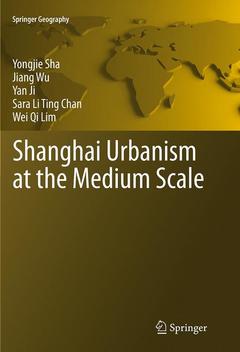Description
Shanghai Urbanism at the Medium Scale, Softcover reprint of the original 1st ed. 2014
Springer Geography Series
Authors: Sha Yongjie, Wu Jiang, Ji Yan, Chan Sara Li Ting, Lim Wei Qi
Language: English
Subjects for Shanghai Urbanism at the Medium Scale:
52.74 €
In Print (Delivery period: 15 days).
Add to cartPublication date: 09-2016
Support: Print on demand
52.74 €
In Print (Delivery period: 15 days).
Add to cartPublication date: 08-2014
192 p. · 17.8x25.4 cm · Hardback
Description
/li>Contents
/li>Biography
/li>Comment
/li>
Associate Professor Yongjie Sha and Professor Jiang Wu work at Tongji University. Yan Ji is an architect and urban designer in Shanghai. Sara Li Ting Chan and Wei Qi Lim work in Singapore as architect and planner in government service.
Yongjie Shais Associate Professor of Architecture & Urban Design at College of Architecture and Urban Planning (CAUP), Tongji University, and Deputy Director of the Institute of Architecture and Urban Space, Tongji University. He received his Doctorate on Architectural History from Tongji University and his MDES from Harvard University Graduate School of Design. Sha’s research and practice focus on the regeneration of Chinese cities under the current urbanization background and based on Asian urbanism study. Sha studied in Tokyo in the late 1990s, taught urban design studio at Pavia University, Italy as Visiting Professor and was Visiting Associate Professor of the National University of Singapore (2010-2012). Sha teaches urban design at Tongji University and meanwhile closely works with city authorities consulting on urban plan issues and urban renewal projects across China. Since 2010 he has been a member of the Urban Space and Conservation Board of Shanghai Urban Planning Committee. His publications include Designing the American City (2004, bilingual, co-authored with Richard Marshall), Shanghai Wukang Road: A Historical Approach to Urban Regeneration (2009, in Chinese, co-authored with Yan Ji and Zonghao Qian) and Towards A New Chinese Urbanity: Urban Design Concept of Shui On Land Developments (2010, in Chinese).
Jiang Wu is professor of architecture at the College of Architecture and Urban Planning at Tongji University, where he received his B. Arch, M. Arch and Doctorate in Architectural History, and became a faculty member in 1986. His research efforts cover the history of architecture and the city, urban planning and design, especially concentrating on Shanghai. He served as the Deputy Director of the Shanghai Urban Planning and Administration Bureau from 2003 to 2008. Since 2008 he has been the Vice President of Tongji University. He is a board member of the Architecture Society
Successfully combines long-term observation and experience inside China with international academic research
A series of urbanism studies for most typical districts tracing the city’s historical evolution clearly reveals issues in connection with current developments
Supplements conventional academic approaches with opinions from city building implementation circles, helping to reflect a broad spectrum of voices and to understand the realities on the ground
Includes supplementary material: sn.pub/extras




